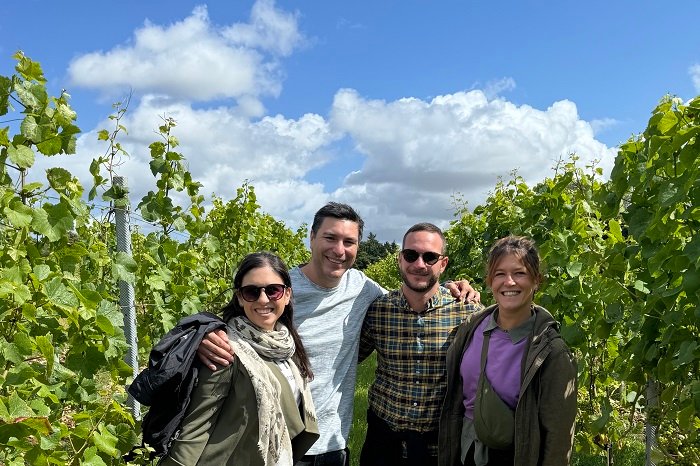Journey to southern England, specifically Hampshire, to discover English sparkling wines, the famous English Sparkling Wines.
I have been visiting Hampshire, discovering theEnglish Sparkling Wine And the result was-amazing! This is truly the land of sparkling wines. It is the varieties grown and how the climate conditions their maturation that suggest it is the perfect land for the production of bottle-fermented wines.The story is yet to be written, it is clear. But the prerequisites, not without some difficulty, are all there.
The south of England is a meeting pot of cultures. Oltre a enologi inglesi, dall’esperienza internazionale, ci sono tecnici di origine spagnola, portoghese, persino cilena. Come le mie due splendide guide, Claudia Lopes, dal Portogallo oggi è laboratory and quality control manager at Hattingley Valley, and Juan Montenegro, Chilean and assistant wine maker at The Grange. I thank them right away for their helpfulness and professionalism, they were my guide and my calling card in the wineries we visited. A few Italians are missing indeed-who wants to be first?
A story yet to be written
Those responsible for the amazement are the wines, no doubt, but not only that. The atmosphere there, the open-mindedness and that feeling that you can be the architect of your own destiny were the most electrifying elements.
The grape varieties are “always the same,” sure, the method is “always the same,” sure but the story is all to be written.
Let’s go in order, because clearly not all that glitters is gold, and see what I learned, what I understood but most importantly what I tasted.
First, some numbers. 2023 data see production in favor of sparkling over stills with 76 percent and a 91% of sparklings are classic method. Il 2023 ha visto la produzione assestarsi su 6.2 milioni di bottiglie di spumante sold. Questo ci porta a fare diverse considerazioni soprattutto relativamente agli affinamenti, ne parlerò però più avanti.
The grape varieties

A southern England, in Jane Austen’s countryside, among country roads, hedges tracing the straight and narrow, meadows and woods sprout here and there real garden vineyards. Ordinati in filari a spalliera, inerbiti e curati, circondati da cancelli o staccionate, sorgono vigneti popolati per lo più da varietà tradizionali per la produzione di spumanti a rifermentazione in bottiglia. Francesi docet, With Chardonnay, Pinot Noir and Meunier. Con un 32%, lo Chardonnay è la varietà maggiormente rappresentata; attualmente anche varietà regina in Hampshire dove sono stata in visita io. Seguono Pinot Nero con il 27% e Meunier con il 9%. Quest’ultima varietà sta incuriosendo e specifiche aziende non solo ci credono ma ci investono parecchio.
Management is mostly conventional, with an unavoidable focus on the sustainability, be it environmental, social and especially economic. The soils: typically limestone (especially in Hampshire), in other areas heavier and cooler to clays and mixed mixtures between clay and limestone.
The climate

Well that the weather in England is rainy you don’t need me to tell you. Rainy, humid but also surprisingly breezy. They tell me not so much actually, although while I was there the breeze to move the shoots and dry the clusters was really never lacking.
Cloudy weather is not only humidity at any rate. But also clouds, thus limited and sometimes undirected insolation of leaves and clusters with consequent feedback on the ripening of the clusters themselves.
Rain and little sunshine are responsible for unobtrusive aromatic ripening; it will certainly not be the explosion of aromas that will involve you in these wines, nor the sovereign element. In fact, acidity reigns supreme in these wines.
Rain is also responsible for a climate that is absurdly mild, or rather devoid of dramatic temperature swings between seasons. Mitiga specialmente l’inverno, mai realmente rigido e responsabile di germogliamenti di certo non precoci, ma nemmeno tardivi. I giovani germogli primaverili sono infatti soggetti alle gelate tra aprile e giugno.
Moisture and spring frost are the two elements to be monitored and administered with proper precautions. Yet it is precisely the English climate, which might seem hostile at times, that is the real element that suggests what are the best and ideal wines to produce here. But let us proceed in order.
Acidity and longevity
Already mentioned that acidity, thanks to how the climate conveys ripening, is the sovereign element in these wines. So different on tasting from the Italian ones, which in contrast have aromatic facets and a deep savoriness on the palate.
High acidity and low pH also seem to be prerequisites for the longevity Of these sparkling wines. A characteristic that leads us to make considerations about the ideal recipe between aging on the lees and corking in the bottle. I mentioned this in the opening, talking about bottles sold.
The fact is that sales are going well, there are several countries between northern Europe and Asia to appreciate English sparkling wines, to the point that allowing long stays on the lees and cellar stays post-disgorgement is not so easy (storage space also begins to be an issue). Here, then, is where acidity often does not find proper space and time to integrate and somehow settle becoming a harmonious, if predominant, element in the wine itself.
The suggestion might be to keep the bottles purchased for a few months before uncorking them (or putting them on sale in the case of restaurants, wine bars, pubs).
If what has been said so far has intrigued you, follow the next “installments,” tomorrow and the day after tomorrow, when I will finally present the wines tasted.





